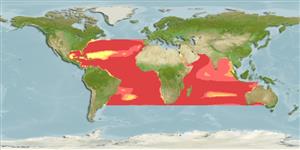Common names from other countries
>
Stomiiformes (Lightfishes and dragonfishes) >
Stomiidae (Barbeled dragonfishes) > Astronesthinae
Etymology: Astronesthes: Greek, astra = ray + Greek, esthes, -es = suit, something used to wrap (Ref. 45335).
More on author: Richardson.
Environment: milieu / climate zone / depth range / distribution range
Écologie
marin bathypélagique; profondeur 0 - ? m (Ref. 5951). Deep-water; 43°N - 36°S
Atlantic Ocean: through most of the Atlantic, from about 43°N to 36°S, but absent in the west from 5°N to 20°S. Elsewhere, Indian Ocean.
Taille / Poids / Âge
Maturity: Lm ? range ? - ? cm
Max length : 16.0 cm SL mâle / non sexé; (Ref. 4465)
Description synthétique
Clés d'identification | Morphologie | Morphométrie
Épines dorsales (Total) : 0; Rayons mous dorsaux (Total) : 14 - 17; Épines anales: 0; Rayons mous anaux: 12 - 16. Black in color, pale luminous patches on middle of snout and along front of upper jaw (Ref. 3982). Pale luminous patches develop with growth on shoulder and on lower sides between pectoral and pelvic fins below dorsal (Ref. 3982). Body moderately elongate and slender, maxillary teeth comblike. Serial photophores are not broken into small groups (Ref. 37039).
An oceanic and mesopelagic species usually found deeper than 500 m during the day. Feeds on midwater fishes and crustaceans. Most common species taken in surface nets at night (Ref. 2802).
Life cycle and mating behavior
Maturities | Reproduction | Spawnings | Egg(s) | Fecundities | Larves
Gibbs, R.H. Jr., 1990. Astronesthidae. p. 300-307. In J.C. Quero, J.C. Hureau, C. Karrer, A. Post and L. Saldanha (eds.) Check-list of the fishes of the eastern tropical Atlantic (CLOFETA). JNICT, Lisbon; SEI, Paris and UNESCO, Paris. Vol. 1. (Ref. 4465)
Statut dans la liste rouge de l'IUCN (Ref. 130435)
CITES (Ref. 128078)
Not Evaluated
Menace pour l'homme
Harmless
Utilisations par l'homme
Outils
Articles particuliers
Télécharger en XML
Sources Internet
Estimates based on models
Preferred temperature (Ref.
115969): 9.2 - 20.6, mean 14.2 (based on 612 cells).
Phylogenetic diversity index (Ref.
82804): PD
50 = 0.5000 [Uniqueness, from 0.5 = low to 2.0 = high].
Bayesian length-weight: a=0.00417 (0.00171 - 0.01014), b=3.05 (2.83 - 3.27), in cm Total Length, based on LWR estimates for this (Sub)family-body shape (Ref.
93245).
Niveau trophique (Ref.
69278): 3.8 ±0.62 se; based on food items.
Résilience (Ref.
120179): Milieu, temps minimum de doublement de population : 1,4 à 4,4 années (Assuming tmax>3).
Fishing Vulnerability (Ref.
59153): Low vulnerability (10 of 100).
